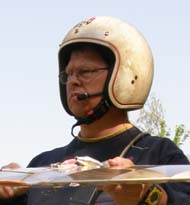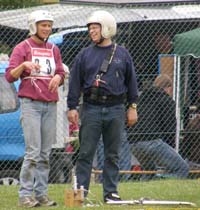Strategy for winning at F2D Combat
First published: 6/3 2012 - Last update: 6/3 2012
by Henning Forbech
|
|
||
|
Success at combat is not just about flying skills, good models and strong engines. Sometimes you can improve your chance of winning by flying tactical. Flying low inverted, tricking your opponent to hit the ground, giving away the streamer or early landings are all well-known tactics. Two years ago I developed and used a new strategy to improve my chances against strong pilots. Here is the history of the "F2D Blitzkrieg Strategy" |
Part 1 - Background Part 2 - The strategy Part 3 - Special equipment Part 4 - Proof of concept Part 5 - Bladder design Part 6 - Spin-off Part 7 - Next step Part 8 - More info |
|
|
|
||
|
Part 1 - Background:
2009 was the first season with mandatory shut-off systems in F2D Combat. There were a lot of different shut-off designs available and all pilots were trying to find the system that suited them best. Many pilots found the weight of the shut-off to be critical and they were changing the shut-off design just to save a few grams. I found this focus on weight to be out of proportions and regarded the function and reliability of the system as being more important. On the trip to the 2009 Dnipro Cup in Ukraine I had a lot of time to discuss shut-off systems with Stanislaw Chornyy. He also found the weight of the device to be very important. My objection to the weight problem was that it is very difficult to feel the difference from a few grams extra when you are flying. In the discussion with Chornyy I even stated that most of the pilots would probably not be able to tell the difference between a model with a full bladder and the same model with an almost empty bladder. During the long travel from Kiev down to Novomoskovsk we were even talking about making some test flights to see if pilots could estimate the actual weight of a model. The weight should be regulated by adding some extra weight to the model and after the test flight the pilot should they try to guess how much have been added to his model. We never found time for this experiment. |


|
|
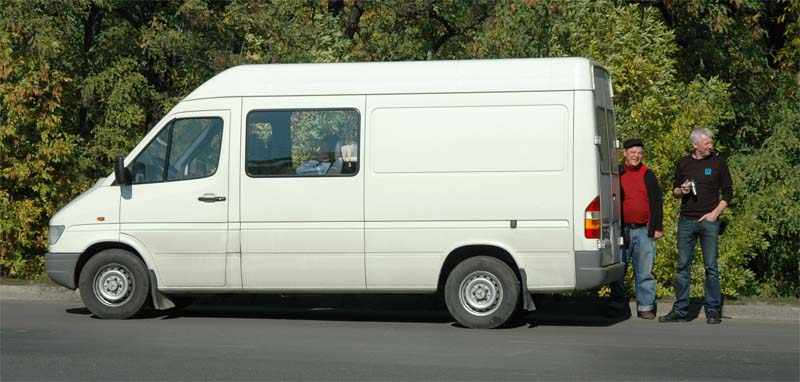 |
||
|
When I came back from the trip to Ukraine, I got some time to reconsider the problem and found a way to combine some of the wild ideas into a new strategy. First I realized that Chornyy was right. Weight does make a big difference. But if a light model would perform much better than a heavy model it should be possible to give your model "turbo power" through a drastic weight reduction. Just imagine your model was 70 gram lighter than your opponent's model! With an ordinary engine on a standard model you should be able to match a top pilot with a super model and a top class engine. The lower weight would reduce the speed loss in maneuvers and it should be possible for you to keep up with his model in a tight dog fight. An easy way to reduce weight would be cutting down the amount of fuel in the model. Back in 2009 110 ml of fuel was standard for a bout with 1 minute warm up and 4 minute combat. 110 ml fuel is close to 100 g but if this weight was reduced by 70 g there would only be fuel enough for the first minute of the match. By reducing the amount of fuel you will be able to give your model "turbo power" but the engine will only run for one minute. |
Weight reduction is the key to give your model super performance! 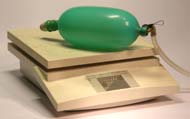 Reduce the weight of the fuel??? |
|
|
Part 2 - The strategy: |
||
|
If you have to fly a top pilot your chance of winning is normally quite low.
By giving you model "turbo power" for a short period you might improve your chances.
You just need to plan how to use the "turbo power".
The strategy should now be to start the match with fuel for only one minute in the first model. In this first minute the performance of your light model will match or maybe even outperform the top pilot's model with a full load of fuel. After the first minute you will have to land and change to the second model. But if you can manage to get ahead with at least one cut before this built in pit stop there will be time enough for this change. When the second model gets back into the air you should still be ahead by 10 seconds or more. When the combat starts again you will be almost half way through the match. You will be leading on points and your first model will only need a refueling to be ready again. If you manage to defend your position for the last two minutes you should be the winner! This is a very risky strategy. If you do not get ahead in the first minute the built in pit stop will cost you a lot of ground time. This will almost certainly mean losing against a top pilot. If both you and your opponent take the whole streamer in the classic 1-1 cut event you will also lose from the pit stop. To improve your chance of getting ahead at the start of the bout you must use the fact that your opponent does not expect you to match him in a tight dog fight. By flying very offensively you should be able to take him by surprise. First he will probably see your aggressive strategy as being a little crazy but when he realizes that you are actually capable of matching or even out preforming him in maneuvers he will be chocked. He will then have to rethink the situation and start to fly you as if you were a top pilot. The strategy for this first minute is like going into a 12 round boxing fight and trying to win on a knock out in the first 10 seconds. Take your opponent by surprise and hit him hard before he finds out what is going on. If you manage to make a good score in this first hectic part of the bout you will have a good chance of winning. If not you will lose and it make no difference if you lose with 10 seconds or 3 cuts. This strategy is very similar to the "Blitzkrieg" strategy used by Nazi Germany at the assaults on France, Poland and Russia in World War II. The key to success is to paralyze you opponent by a very rapid and aggressive strategy. If you can surprise and keep him off-balance for some time you might get a decisive position before he find an effective response to your strategy. |
Background info: History Channel Battleplan "Blitzkrieg" (Television documentary) 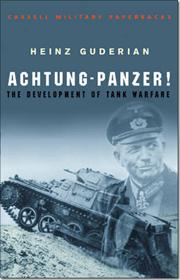
The battleplan for the classic Blitzkrieg is from the book: "Achtung Panzer!" by Heinz Guderian More info on classic war strategy |
|
|
Part 3 - Special equipment: |
||
|
The Blitzkrieg strategy does have a practical problem. If you fill up your model with fuel for a one minute flight your engine will only run at full speed for the first 30 seconds. Then it will start to run rich and right before the engine stops it will speed up and run at full power for a few seconds.
This is well known to all pilots and if your engine has these variations your opponent will soon realize that you are about to run out of fuel. To use a Blitzkrieg strategy you will need full power for the first minute and you engine should stop very quickly when it is out of fuel. The variations in engine speed come from the variations in the fuel pressure in the latex tube right before it is out of fuel. This effect is normally not a problem. You just tank enough fuel to allow for these variations right after the combat period. Some years back I measured the pressure in a latex bladder. Here is a speeded up video clip of how the pressure is changing as the engine is consuming the fuel: |
How to make bladders for F2D by Gordon Price Pressure fuel systems by Iskandar Taib |
|
|
Measuring the fuel pressure in a latex bladder |
Time-lapse video clip of a latex bladder 5˝ minute fuel supply condensed down to 20 seconds |
||||
|
If the fuel pressure is plotted versus time you will get this graph.
It is easy to see how the pressure slowly drops as the fuel is leaving the bladder but when the bladder is almost empty the pressure will rise drastically and drop again very fast as the latex tube is coming back to its relaxed shape 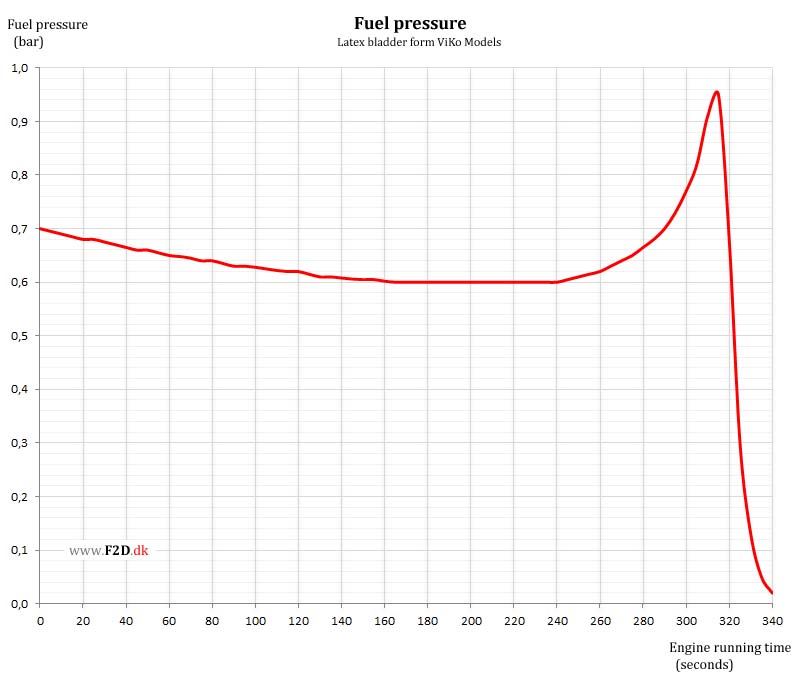
|
|||||
|
Here you see how the fuel pressure will vary through a typical flight.
The pressure is actually declining for the first half of the flight and you have to adjust the engine a little rich at take-off to get the best setting throughout the combat period.
At the end of the flight the pressure rises drastically shortly before the bladder runs out of fuel. It is this pressure variation that cause the typical running rich and speeding up right before the engine stops. |
Wikipedia: Latex rubber |
|
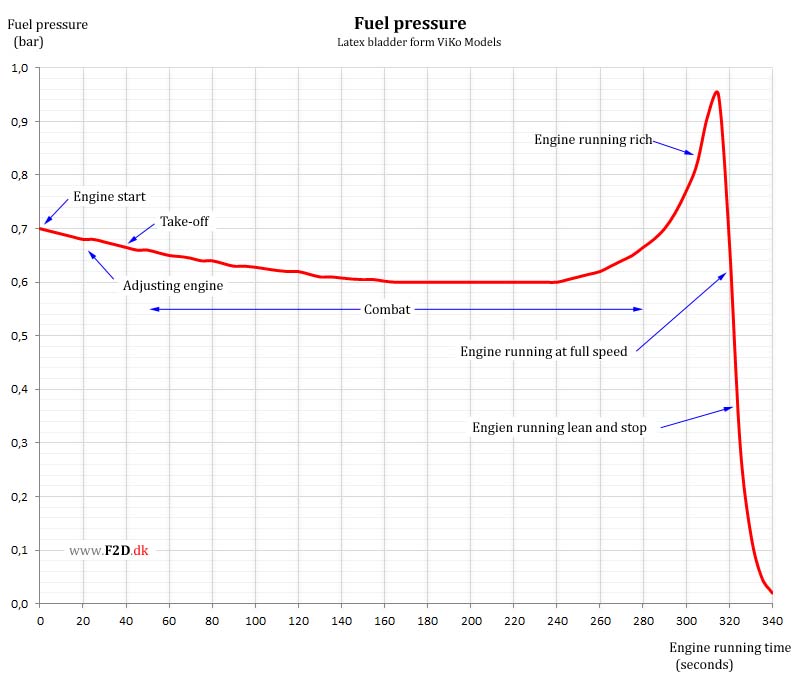 |
||
|
To get the most from the Blitzkrieg strategy it was necessary to find a way to solve the problem with the pressure variation.
The solution was to dig out one of the crazy ideas from the research on shut-off systems.
Back in the early spring 2009 I developed and tested a "Bubble shut-off". By extending the fuel line deep into the latex tube it was possible to fly a model with a mix of fuel and air in the bladder. As long as the model was flying the extended fuel line would pick up fuel from the bladder. If the model was cut off the lines there would be a small chance that the air would get into the fuel line and stop the engine. This design was no good as shut-off system but the bladder design had an interesting feature: It was possible to replace some of the fuel by air without affecting the normal flight. |

The Bubble shut-off system |
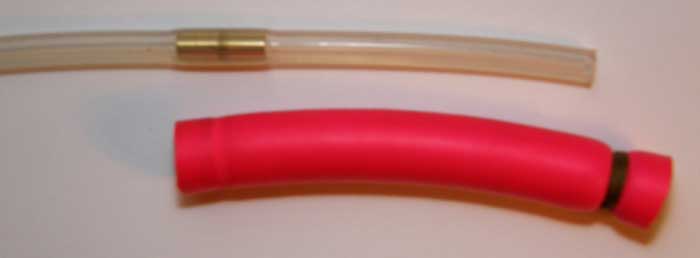  |
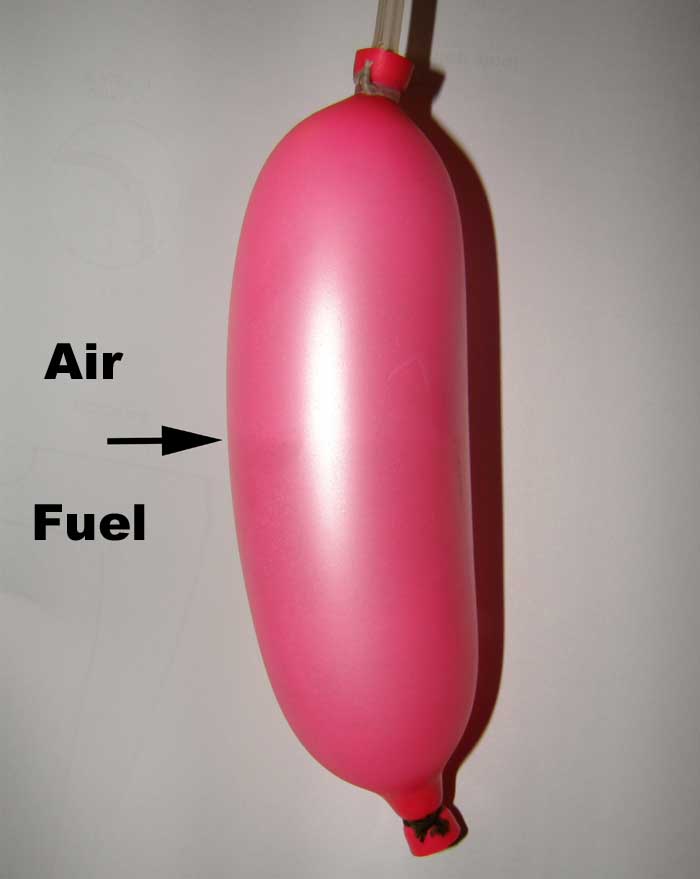 |
|
In the fuel pressure graph the fuel marked with green could be replaced by air. This would eliminate the effect of the rise in pressure when the bladder is almost empty. When the pressure would normally rise in the almost empty bladder there would only be air left in the bladder and instead of running rich the engine would simply stop. 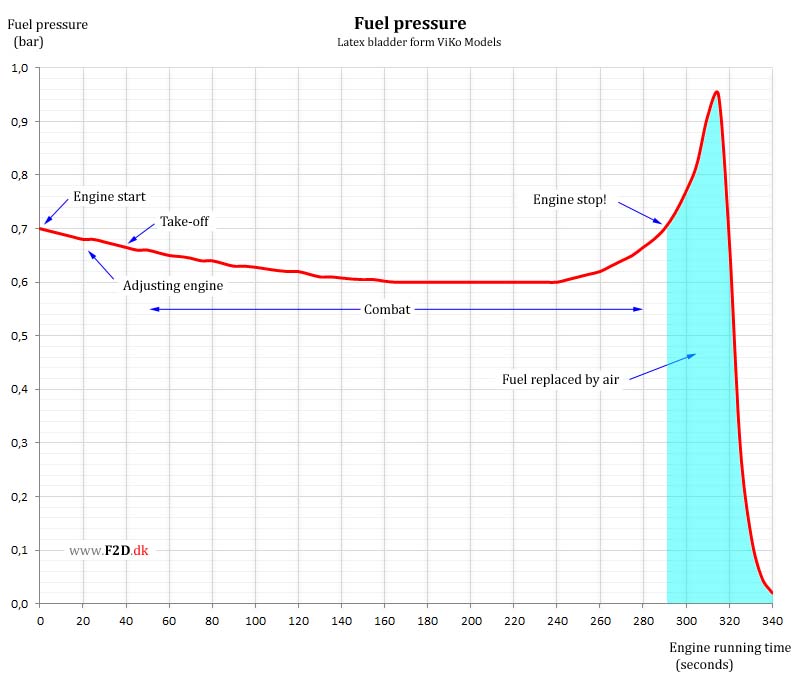
|
|
|
This video clip is from the very first flight with a Bubble shut-off in the spring 2009.
The bladder used in this flight was just an ordinary bladder with the fuel line extended into the latex tube 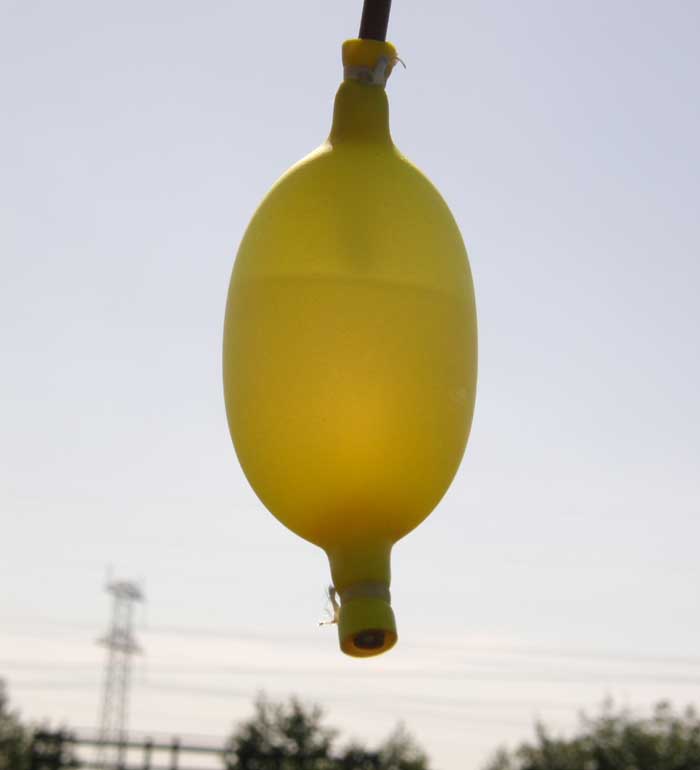
|
Please note how the engine stops. Only 6-7 seconds from the first hick up to the engine is stopped. No running rich and no speeding up at the end! Pilot: André Bertelsen. |
|
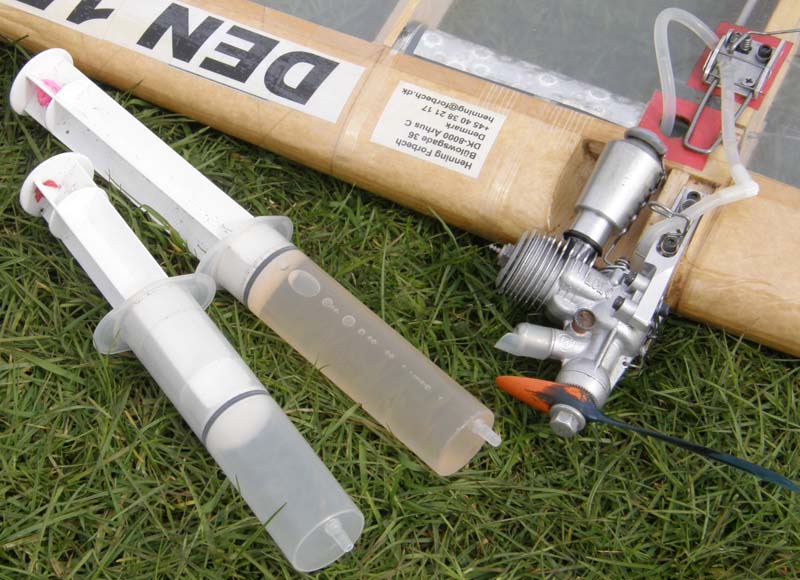 |
||
|
More videos and results from Bitterfeld World Cup 2010 |
|
My next match in the competition was the final against Stanislav Chornyy, Ukraine. The Blitzkrieg strategy gave me some clear advance in the first part of the flight with Audrius so I decided also to try it again against Chornyy. Right from the start I tried to attack as much as possible and the low model weight made it possible for me to follow Chornyy in the tight maneuvers. Shortly before my model would have run out of fuel we had a mid-air collision. We both got the second model up at the same time. I tried to continue in the aggressive flying style but it was difficult without the advantage of a lighter model. After a minute or so we got in to an overhead line tangle. We were using identical shut-off systems and as we start losing line tension both engines began to shut down. At that time I was using a small reservoir between the shut-off and the engine and this little extra fuel kept my engine running just a little longer than Chornyy's engine. Chornyy had to land and I managed to stay in the air. The final ended 4-4 in cuts and I won on air time. You can see the final in these two video clips: |
Moving bellcrank shut-off with a mini swing arm 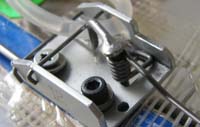
Same shut-off from Chornyy.com 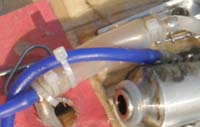
The small reservoir that gave my shut-off a short delay |
|
Camera 1 |
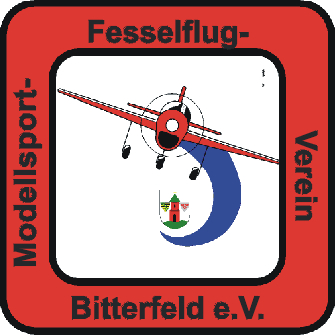
Bitterfeld World Cup 2010 Results and more video clips |
|
|
Camera 2 |
Comments on the competition at the Russian Forum 
Russian English |
|
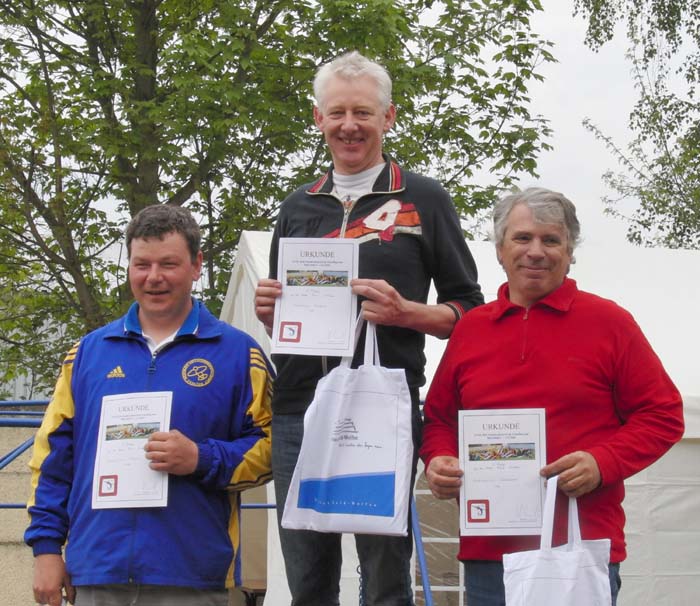 |
||
|
I found it amusing to use the Blitzkrieg strategy against the same pilot that half a year earlier had inspired me to develop the strategy.
When Chornyy visited me later in the spring 2010 for the Dreiländer competition he got a chance at getting a closer look at my equipment. I did not tell him all the secrets of the strategy or what actually was inside the bladder he got in his hand. I could only tell him that he actually gave me the some of the key information that inspired me to develop Blitzkrieg strategy. |
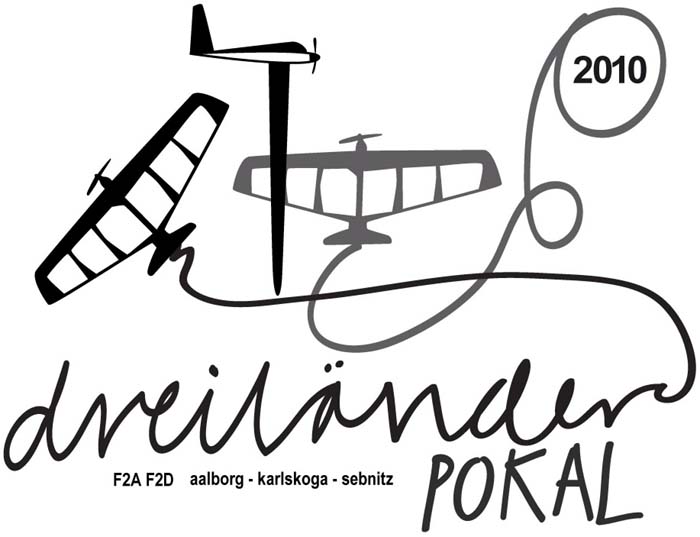
|
|
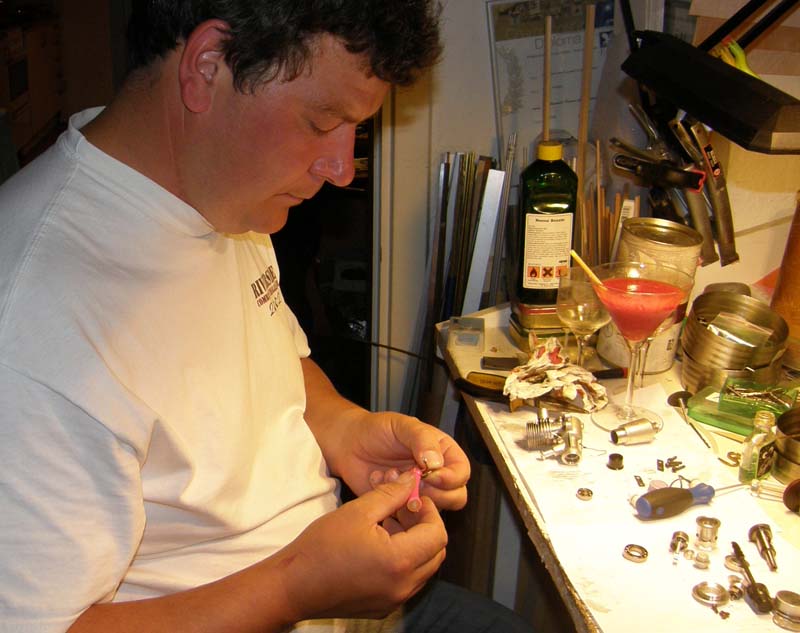 Part 5 - Bladder design: |
||
|
After the first great results with the Blitzkrieg strategy I have tried to improve the bladder design.
First I replace the extended fuel line by a small latex tube. This small tube was connected to a fitting at the end of the bladder and it should be able to flex with the big latex tube. By picking up fuel from the outboard end of the bladder it should be easier for the mechanic to handle the model on the ground. This design did have some problems. Sometime the fuel pressure in the bladder could make the small latex tube collapsed and pinch off the fuel supply. |
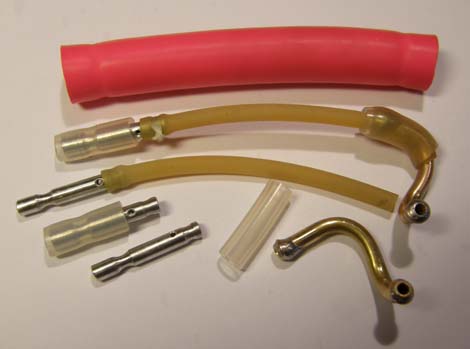
|
|
In the design I´m using now the fuel pick up is a small diameter silicone tube. To keep this tube in the centre line of the big latex tube a spring is mounted from one end of the bladder to the other. This spring is flexing with the bladder and it will always keep the pickup tube in the centre line of the bladder. The spring will also keep the pickup tube open even if the bladder bends. At the bottom of the bladder the spring is connected to an inside threaded plug (this plug is made from an IKEA spare part). The plug also acts as a small reservoir for the fuel and helps the engine run at full speed right to the end. It is a little tricky to connect the spring to the brass tube. Any free spring ends inside the latex tube would be very dangerous for the inflated bladder. The spring wire goes through a small hole in the brass tube, around the tube, back into the small hole and all the way up through the brass tube. The fuel pick up tube will seal off the small hole and protect the latex from the spring wire. I now use this "Blitzkrieg bladder" at all my fights - even when I'm flying with fuel for a full 4 minutes flight. Here is the complete "Blitzkrieg bladder" with the small reservoir on the fuel line. The next photos show the parts inside the latex tube and some close-up details from the threaded plug. |
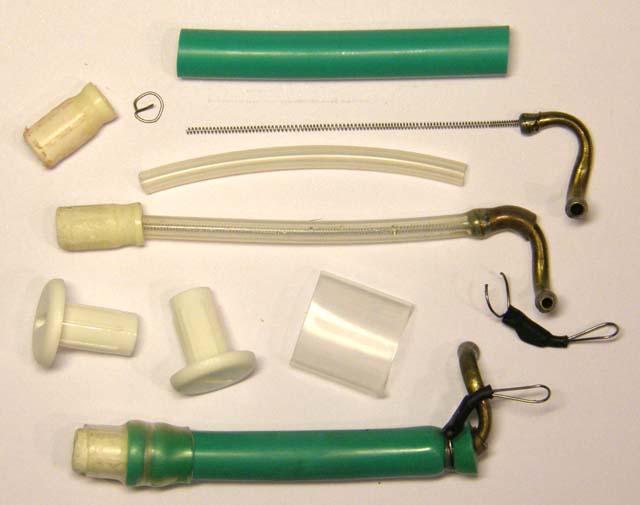 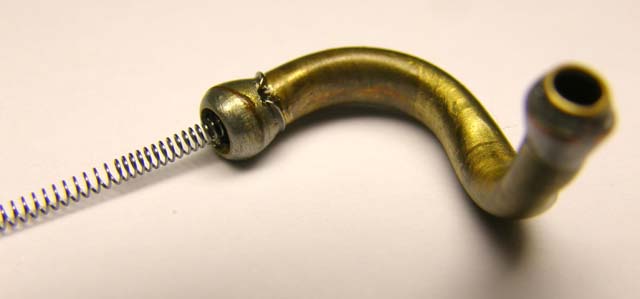 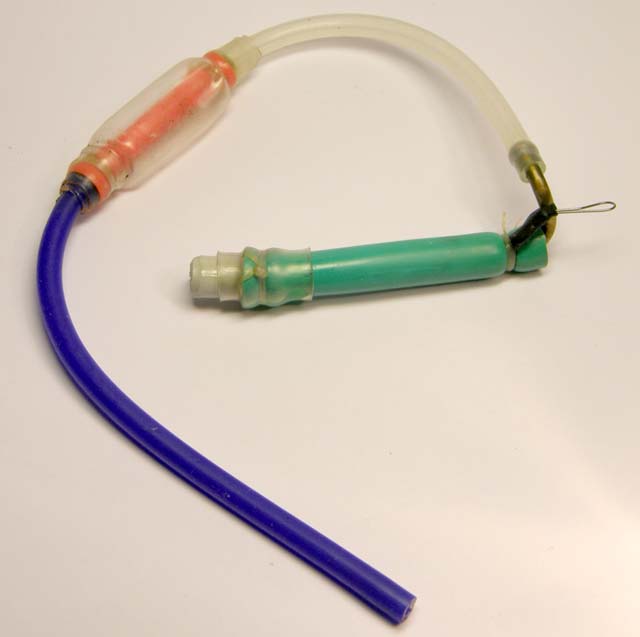 |
|
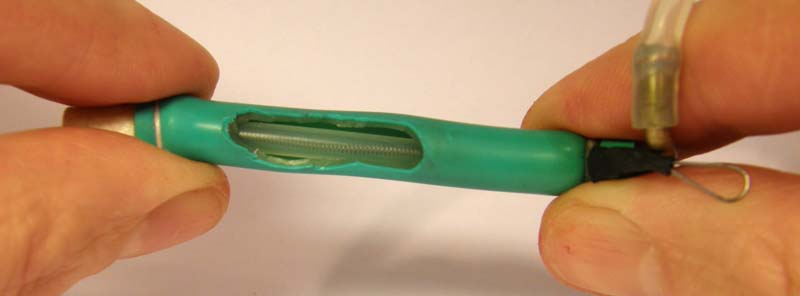 As the bladder is running out of fuel the pickup tube will move towards the outboard end of the bladder. Just the right place to pick up the last drop of fuel. 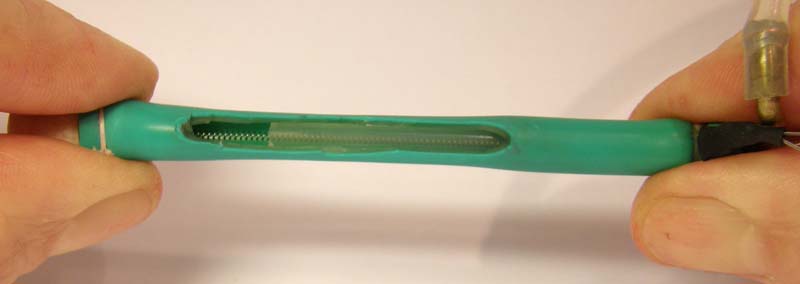
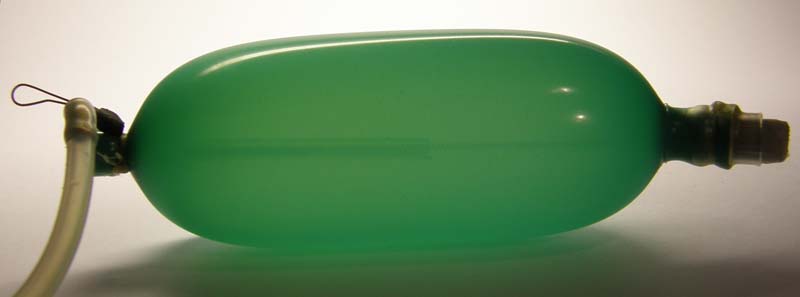 A look though the inflated latex bladder (no fuel - only air) 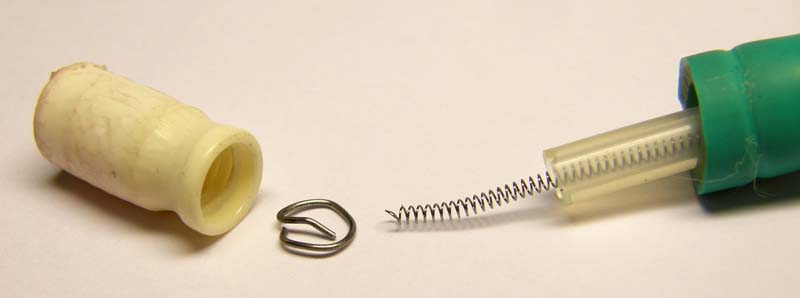 The small spring is fixated to the threaded plug with a wire clip 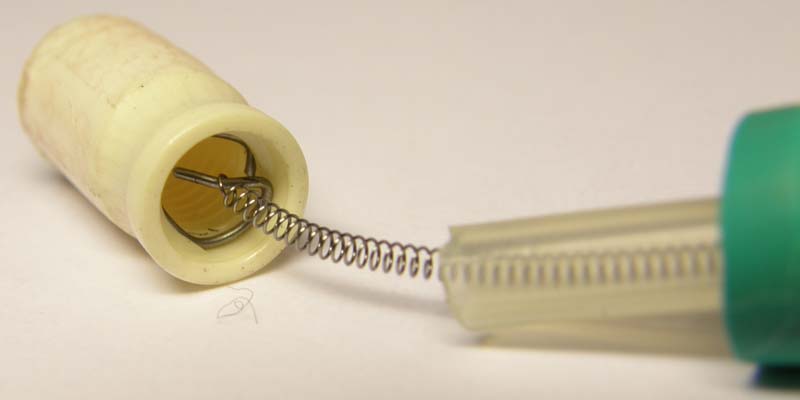 The wire clip can be screwed to the bottom of the plug 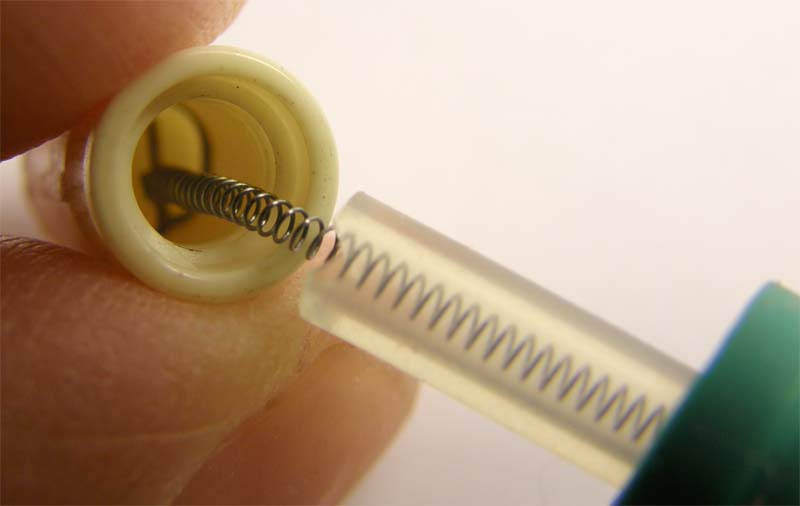 |
||
|
A traditional bladder will normally move to the bottom of the fuel compartment when the model is flying.
The g-force towards the outboard tip will be up to 12 g
See the video clip of the model flying horizontal over the camera More info at the Fact Finding Mission To keep the fuel at the best position in the model the Blitzkrieg bladder is hanging from the center section. By keeping the mass of the fuel closer to the centre of the model the performance of the model will also change less than with the fuel further out in the outboard wing |
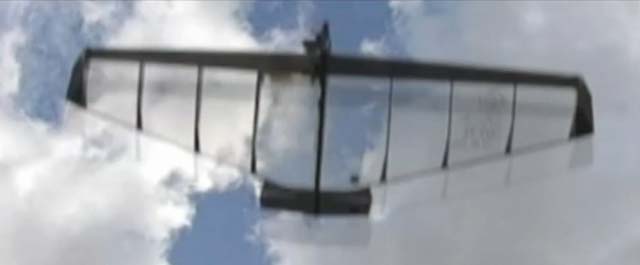 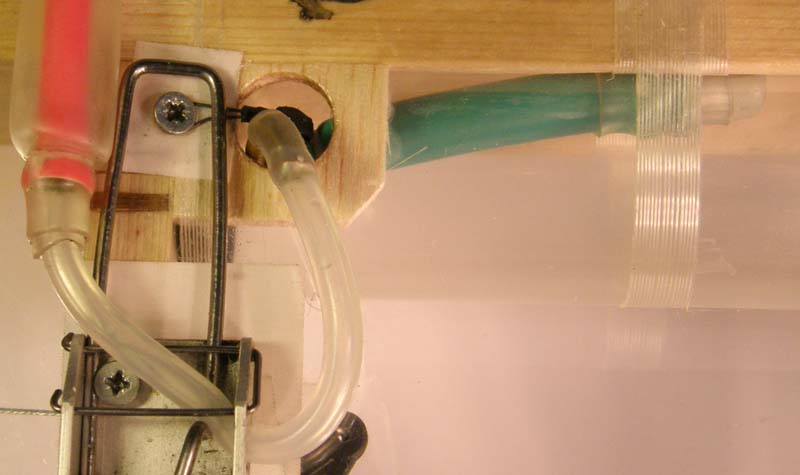
|
|
|
Part 6 - Spin-off: |
||
You may also benefit from the Blitzkrieg bladder design:
|
2013 F2D rules
F2D rules 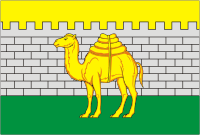 Chelyabinsk |
|
|
Part 7 - Next step: |
||
|
Inspired by the good results with the Blitzkrieg strategy I'm now working on a brand new strategy for the 2012 season.
I cannot tell all the secrets here but you might get a first-hand experience with this new strategy when we meet at a competition in the upcoming season. See you at the circle /Henning Forbech 6/3 2012 |
Comments on this article can be found and made in different debate forums: Barton - FAS Combat-1 |
|
|
Part 8 - More info: More information on F2D strategy, training process, etc. can be found here Here is some books on classic war strategy: |
||
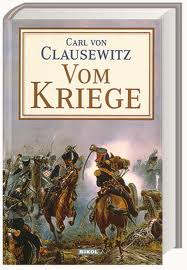
Vom Kriege by Carl von Clausewitz |
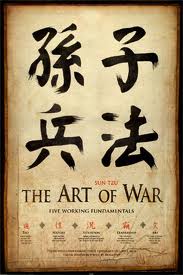
The Art of War by Sun Tzu |

The battleplan for the classic Blitzkrieg is from the book: "Achtung Panzer!" by Heinz Guderian |
|
|
||
|
-oOo- |
||
